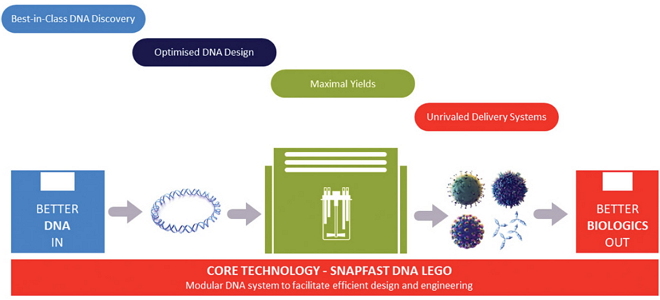

Synthetic biology is an exciting and rapidly evolving field of research that can broadly be defined as the design (or redesign) and construction of novel artificial biological pathways, organisms, or devices. Applying engineering principles to biological components allows us to probe, manipulate, and modify cell function.
The core synthetic biology toolkit is comprised of both biological and engineering functions: molecular manipulation, deep data analysis, and computer algorithms. Below are just a few innovations highlighted at the SynBioBeta conference, which took place in London in April.
“Synthetic Biology is here to stay,” says John Sgouros, consultant, Biomax Informatics. “Customization of molecules and whole microorganisms creates tremendous opportunities in the pharmaceutical industry, environmental biotechnology, and industrial materials. However, optimizing the discovery, genetic engineering, and manufacturing processes driving these innovations is highly dependent on systematic analysis of vast amounts of data.”
Data accumulate rapidly and exponentially, often in an unstructured manner, siloed between internal and external databases, according to Sgouros.
“Biomax’s BioXM knowledge management platform deals with data in a systematic manner: from digitalization to the semantic integration of diverse content and workflows, and further, to systematic feedback of results to find the optimal way forward. Database integration is done by configuration (i.e., point-and-click) without the need to write source code—a huge advantage,” continues Sgouros.
To the end user, the BioXM platform delivers a graphical representation of biomedical knowledge about a given subject, which is easy to explore by clicking on any data field, relationships indicated by connecting arrows. Beneath the user interface is a vast semantically organized knowledge space comprising hundreds of thousands of data elements from published genetic and biochemical information, laboratory notebooks, pharmaceutical databases, electronic health records, and other resources.
Biomax’s proprietary algorithms also extract knowledge from literature and present the end user with a systematic overview of information about genes, biomolecules, drugs, etc., as an interactive map. A powerful example of BioXM application is in personalized medicine, profiling patients with chronic obstructive pulmonary disease (COPD) based on comorbidities and response to rehabilitation. Multidimensional data from over 5,000 COPD patients at the CIRO+ hospital in The Netherlands were integrated with BioXM and analyzed using the Biomax Viscovery software.
The resulting self-organizing maps identified patient clusters with significantly different profiles. Implementation of the clustering in the clinical setting enabled a customized therapeutic approach for each new patient, with considerable costs savings to the hospital. BioXM also forms the knowledge management core for PREPARE [Platform for European Preparedness Against (Re-)emerging Epidemics], analyzing relationships between pathogens and resulting pathophysiology. BioXM is unique as a knowledge management platform seamlessly linking clinical phenotypes to biochemical pathways, pharmacology and genetic variation, along with drug discovery and synthetic biology.

“Recognizing natural rules in relationships between DNA, RNA, and transcription machinery is the holy grail of synthetic biology,” says Tahel Altman, M.D., CEO, SynVaccine. “We are continuously perfecting a synthetic biology-driven approach, called SynRad, which systematically evaluates the effect of different nucleic acids features on the resulting “phenotypes” of transcripts and even whole organisms. Once the rules of causality are understood, these rules could be modified to build entirely synthetic organisms with engineered characteristics.”
SynVaccine designs/builds viruses for applications such as human and animal vaccines, specifically aiming at immuno-oncology applications. Dr. Altman explains that modifying viruses by random mutagenesis or by manipulating a specific gene is laborious and time consuming. Synthetic rational design of viruses offers a promise of a continuous pipeline of personalized cancer therapies. SynVaccine can alter viral replication rate, or specificity to a host.
“Most of our rules are proprietary,” contends Dr. Altman. “But exploiting just a few of them underscores our ability to shorten viral vaccine development.”
SynRad algorithms specifically protect desired viral characteristics, such as core protein function or immunogenicity, but introduce hundreds of silent mutation to attenuate viral properties in an optimal way. For example, dengue virus replication depends on the strength of the mRNA folding in different regions. SynVaccine performed a large-scale genomic analysis of reciprocity between dengue RNA folding strength in different positions in the genome and replication rates. The company compared hundreds of individual dengue coding regions to identify signals indicative of functional effect of folding strength. The computationally predicted positions with weak/strong folding signals were modified to create a series of synthetic viruses with variable replication rates. The initial animal data proved that some of the attenuated variants are able to persist in the host without eliciting disease.
Dr. Altman points out that predictable, repeatable, and self-improving generation of synthetic viruses produces a renewed hope for antiviral vaccines as well as creating new hope for cancer treatment using a more accurate viral-based therapy. “Even if we do not understand all the details in the underlying mechanisms, we could discover novel patterns and alter them to change viral specificities,” she says.

“Most medicines in the future will be DNA-based biologics,” contends Ryan Cawood, D.Phil., CEO, Oxford Genetics. “As genetic data become more readily available, DNA-based medicines will become indispensable for personalized treatment approaches.” Dr. Cawood described challenges that slow down new biologics R&D: difficulties in discovering new molecules, high complexity of molecular engineering, inefficiency of biologics manufacturing, and the deficiencies of delivery systems. Oxford Genetics guides and supports biologics evolution through understanding how DNA behaves.
“Better DNA in, better biologics out,” offers Dr. Cawood. The foundational technology, SnapFAST, is a LEGO®-like core DNA system of modular blocks. By selecting predesigned DNA parts, such as promotors and enhancers, combined with their own optimized sequence, the company’s customers can make rapid progress in building new human treatments. For example, a novel adenovirus-based gene-therapy system that can deliver DNA into a wide range of cell types, or proprietary algorithms for designing and discovering new DNA sequences and developing antibodies against complex mammalian membrane antigens such as GPCRs.
“Given that we have over 3,000 validated starting DNA systems, this allows us operate in a diverse synthetic biology space, and enables us to offer services using our LEGO-like DNA systems to help discover, develop, and deploy biological therapies more effectively for our commercial collaborators,” says Dr. Cawood.
In 2017, the company also received two substantial grants from Innovate UK for projects that help to integrate the synthetic biology design-build-test cycle to improve protein library design and discovery alongside improving the efficiency of mammalian cell-line engineering. These projects will seek to mine existing datasets, whilst simultaneously developing assays that provide data to allow the development of algorithms that predict cellular behavior and virus and protein production. The company aims to enhance therapeutic molecules along with the bioproduction of the host lines in which they are manufactured.
“We consistently build on previous innovations around DNA design algorithms, automation platforms, and viral packaging systems. The internal R&D projects we are pursuing aim to deliver a quantitative change in the current bioproduction methods, meeting unmet needs of the gene therapy and immunotherapy fields,” says Dr. Cawood.
